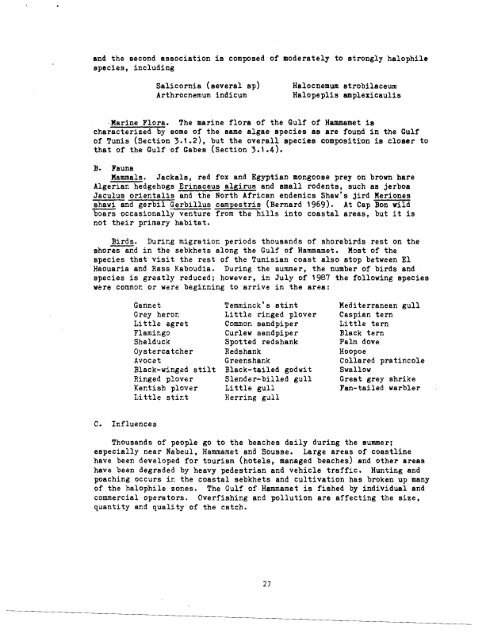biological diversity and tropical forests in tunisia - PART
biological diversity and tropical forests in tunisia - PART
biological diversity and tropical forests in tunisia - PART
You also want an ePaper? Increase the reach of your titles
YUMPU automatically turns print PDFs into web optimized ePapers that Google loves.
<strong>and</strong> the second association is composed of moderately to strongly halophile<br />
species, icclud<strong>in</strong>g<br />
Salicornia (several sp) Halocnemwn etrobilaceum<br />
Arthrocnemum <strong>in</strong>dicum Halopeplis amplexicaulis<br />
.Mar<strong>in</strong>e Flora. The mar<strong>in</strong>e flora of the Gulf of Hammamet is<br />
characterized by eome of the same algae species as are found <strong>in</strong> the Gulf<br />
of Tunis (section 3.1.2), but the overall species composition is closer to<br />
that of the Gulf of Cabes (section 3.1.4).<br />
B. Fauna<br />
Mammals. Jackals, red fox <strong>and</strong> Egyptian mongoose prey on' brown hare<br />
Algeriac hedgehogs Er<strong>in</strong>aceus algirus <strong>and</strong> small rodents, such as jerboa<br />
Jaculus oriectalis <strong>and</strong> the North African endemics Shaw's jird Meriones<br />
- shawi an-erbillus campestris (~ernard 1969). At Cap Bon wild<br />
boars occasionally venture from the hills <strong>in</strong>to coastal areas, but it is<br />
not their primary habitat.<br />
Birds. Duricg migratioc periods thous<strong>and</strong>s of shorabirds rest on the<br />
shoras a ~ d <strong>in</strong> the sebkhets along the Gulf of Hammamet. Most of the<br />
species that visit the rest of the Tunisian coast also stop between El<br />
Haouaria <strong>and</strong> Rass Kaboudia. Dur<strong>in</strong>g the summer, the number of birds <strong>and</strong><br />
species is gr6atly reduced; however, <strong>in</strong> July of 1987 the follow<strong>in</strong>g species<br />
were commor. or ware begim<strong>in</strong>g to arrive <strong>in</strong> the area:<br />
C. Influences<br />
Gannet<br />
Grey heror.<br />
Little 5gret<br />
Flamicgo<br />
Shelduck<br />
Oystercatcher<br />
Avocet<br />
Black-w<strong>in</strong>ged stilt<br />
R<strong>in</strong>ged plover<br />
Kectish plover<br />
Little st<strong>in</strong>t<br />
Temm<strong>in</strong>ck' s st<strong>in</strong>t<br />
Little ricged plover<br />
Commoc s<strong>and</strong>piper<br />
Curlew s<strong>and</strong>piper<br />
Spotted redshank<br />
Redshank<br />
Greenshank<br />
Black-tailed godwit<br />
Slender-billed gull<br />
Little gull<br />
Herr<strong>in</strong>g gall<br />
Mediterranean gull<br />
Caspian tern<br />
Little tern<br />
Black tern<br />
Palm dove<br />
Hoopoe<br />
Collared prat<strong>in</strong>cole<br />
Swallow<br />
Great grey shrike<br />
Fan-tailed warbler<br />
Thous<strong>and</strong>s of people go to the beaches daily dur<strong>in</strong>g the eummer;<br />
especially near Nabeul, Hammamet <strong>and</strong> Sousse. Large areas of coastl<strong>in</strong>e<br />
have been developed for tourism (hotels, managed beaches) <strong>and</strong> other areas<br />
have been degraded by heavy pedestrian <strong>and</strong> vehicle traffic. Hunt<strong>in</strong>g <strong>and</strong><br />
poach<strong>in</strong>g occurs <strong>in</strong> the coastal sebkhets <strong>and</strong> cultivation has broken up many<br />
of the halophile zoces. The Gulf of Hammamet is fished by <strong>in</strong>dividual <strong>and</strong><br />
commercial opera tors. Overfishicg <strong>and</strong> pollution are affect<strong>in</strong>g the size,<br />
quantity acd quality of the catch.

















